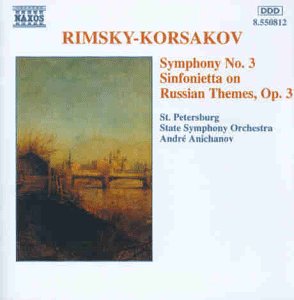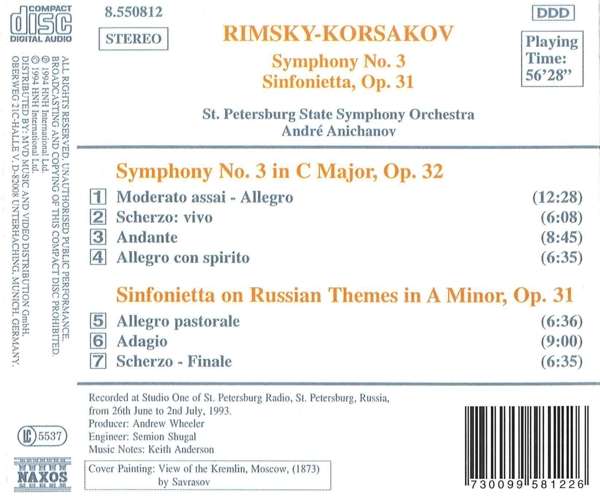
kompozytor
Rimsky-Korsakov, Nikolai
tytuł
RIMSKY-KORSAKOV: Symphonies nos. 3 & 4
wykonawcy
St. Petersburg State Symphony Orchestra;
Anichanov, Andre
Anichanov, Andre
nr katalogowy
8.550812
opis
Rimsky-Korsakov started his Symphony No. 3 in C major in 1873, making use of a Scherzo written in 1863 and a Trio composed during his honeymoon in Italy in 1872. He finished the symphony on 18th February 1874, but performance in St. Petersburg was greeted without any great interest. He revised the symphony completely in 1886, two years after his first revision of the First Symphony. •
The symphony starts with a slow introduction in which the theme of the following Allegro appears. The strong first subject leads to a much gentler second subject and a central development that introduces further drama, before the triumphant recapitulation, melting into the transposed second subject, leading to a final hushed ending. The Scherzo, in its re-orchestrated form, continues to show Rimsky-Korsakov's command of instrumentation, acquired by study and by his experience with naval bands. It seemed to him that the unusual 5 / 4 metre of this second movement might have deterred conductors undertaking performance of the whole symphony. It offers music of great rhythmic vitality and energy and masterly orchestral colouring, to which the Trio provides romantic melodic contrast. The French horn introduces the third movement Andante, followed by other wind instruments and then the strings. The movement increases in tension to a dynamic climax, from which the clarinet leads to a further strongly romantic statement of the principal thematic material. The final Allegro con spirito brings about an element of cyclic unity in its re-use of the principal themes of the earlier movements, achieved with a technical assurance that is always evident and in a musical language of thoroughly Russian cast. •
In the summer of 1879 Rimsky-Korsakov wrote a string quartet on Russian themes, later transformed into the A minor Sinfonietta. The quartet had four movements, with the titles In the Field, At the Charivari, In the Khovorod and By the Cloister. It was played through privately by Auer, Pikkel, Veykman and Davidov, but failed to please either performers or composer. He completed his orchestration of the first three movements used in the Sinfonietta in the summer of 1884, abandoning the liturgically inspired fourth movement, which all had agreed to be dull.
nośnik
CD
gatunek
Muzyka klasyczna
producent
Naxos
data wydania
10-10-1994
EAN / kod kreskowy
730099581226

(Produkt nie został jeszcze oceniony)
cena 58,00 zł
lubProdukt dostepny w niewielkiej ilości.
Wysyłka w ciągu 3 dni roboczych
Darmowa wysyłka dla zamówień powyżej 300 zł!
Darmowy kurier dla zamówień powyżej 500 zł!
sprawdź koszty wysyłki











































